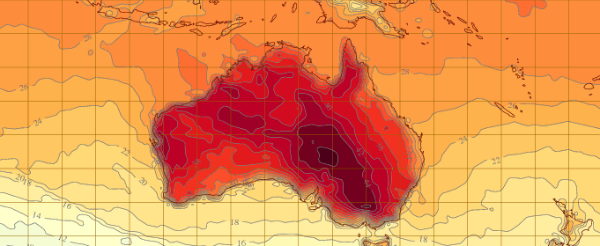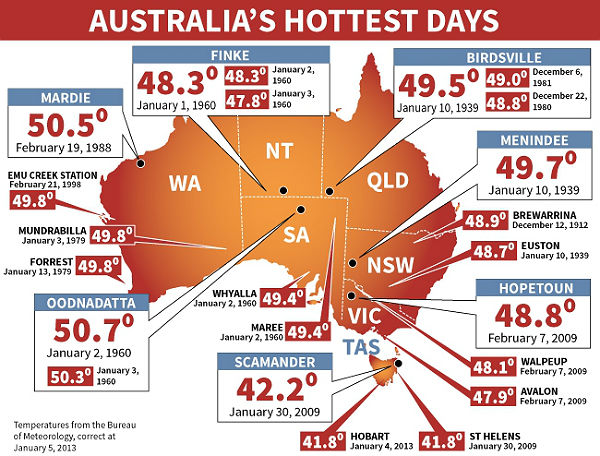Source: The Watchers - 1/08/13, By Chillymanjaro
 Australia experienced the hottest day in recorded history yesterday, on January 7. The average maximum temperature across Australia reached 40.33 degrees Celsius, beating the previous record of 40.17 degrees set in December 21, 1972. There was only three times in recorded history when mercury showed average maximum temperatures above 40 degrees Celsius. Last four months of 2012 broke all previous records with maximum temperatures across the continent 1.6 degrees Celsius above average.
Australia experienced the hottest day in recorded history yesterday, on January 7. The average maximum temperature across Australia reached 40.33 degrees Celsius, beating the previous record of 40.17 degrees set in December 21, 1972. There was only three times in recorded history when mercury showed average maximum temperatures above 40 degrees Celsius. Last four months of 2012 broke all previous records with maximum temperatures across the continent 1.6 degrees Celsius above average.
Hobart, Tasmania also recorded its hottest day in 130 years on January 4, with temperature peaked at 41.8 degrees Celsius.
Australia has never before experienced 5 consecutive days of national-average maximum temperatures above 39 degrees Celsius. The Bureau of Meteorology is warning that the heatwave, which has already affected several states, will continue unabated well into next week.
Large parts of central and southern Australia are currently under the influence of a persistent and widespread heatwave event. This event is ongoing with further significant records likely to be set.
Temperatures soared by 20 degrees Celsius in less than three hours as the heatwave start to cross Australia. According to the Bureau of Meteorology’s automatic weather station, the hottest place in NSW is just west of Kangaroo Valley, with a temperature of 42.7 degrees Celsius. Weather records are tipped to fall in Queensland this week, where the outback town of Birdsville is expected to remain above 45 degrees Celsius all week. The hottest place today is forecast to be Oodnadatta in South Australia, at 46 degrees Celsius.
Bureau of Meteorology forecast that waves of heat will repeat every few days until a monsoon breaks the pattern.
The far south coast of NSW saw dramatic drop in temperatures. At Merimbula, the temperature dropped from 41.1 degrees Celsius to 24.1 degrees Celsius. An east-southeast change is moving north up the coast.
The risk of a local or area-wide power outage increases with the heatwave conditions. Already, Sydney’s Freshwater area was affected by a power outage this afternoon.
According to Markus Donat, from the Climate Change Research Centre at the University of New South Wales, periods of high temperatures have increased in recent decades. He points that for most regions, including Australia, extremely high temperatures have become more frequent and more intense. Extremely low temperatures have occurred less frequently than they did in the middle of the 20th century. The frequency of days in this warmest category has increased by 40% globally during the most recent three decades.
Soaring temperatures and strong winds fuel wild bushfires across Australia and Tasmania (Credit: LANCE/FIRMS)
Dangerous bushfires in NSW are fuelled by soaring temperatures and strong winds. More than 100 fires is burning across the state. Up to 90% of NSW was declared in severe danger – Illawarra, Shoalhaven and Southern Ranges are already classed as catastrophic. A bushfire in Victoria’s southwest had almost doubled in size by now. And there are more than 40 bushfires blazing across Tasmania and the state’s southeast are being told it is too late for people to leave.
Sources: TheAustralian, News.com.au, FIRMS
Featured image credit: Bureau of Meteorology/ACCESS




